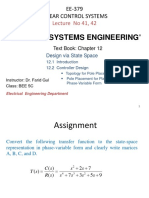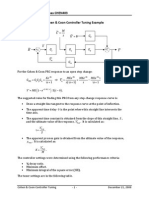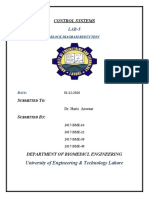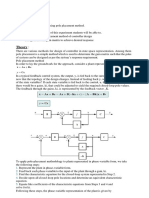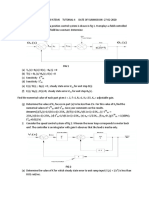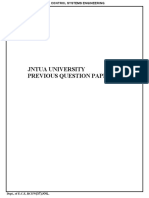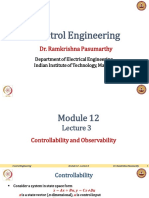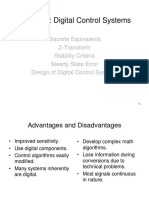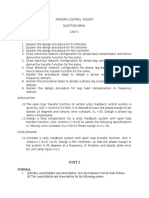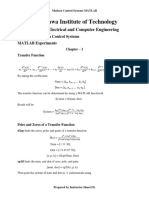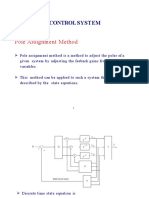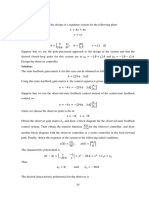0 ratings0% found this document useful (0 votes) 166 views30 pagesMSC CH - 5
Copyright
© © All Rights Reserved
We take content rights seriously. If you suspect this is your content,
claim it here.
Available Formats
Download as PDF or read online on Scribd
Arba Minch University
Arba Minch Institute of Technology
Faculty of Electrical and Computer Engineering
Modern Control System
ECEE-4331
Chapter 5.Design Via State Space�Introduction
+ State-space techniques can be applied to a wider class
of systems than transform methods, for example, a
systems with nonlinearities, MIMO systems
+ Frequency domain methods of design, cannot be used
to specify all closed loop poles of the higher order
system
+ State-space technique allow to place all poles of the
closed-loop system.
+ State-space methods do not allow the specification of
closed-loop zero locations
+ Frequency domain methods do allow through placement
of the lead compensator zero.
+ State-space design may prove to be very sensitive to
parameter changes.�Controller De:
An nth order feedback control system has the following
characteristic equation
SHG, ST eee +as +a, =0
Pole Placement » Geet ep
A plant shown in (a) is 4
represented in state space by r
xX = Ax +Bu @
y =Cx rs ly e+] x cL!
The state equation for ‘
the closed loop system “
in (b) can be written as
-K
. ()
X= Ax+Bu=AX+B(-Kx+r)=(A-BK)x+Br 4g. State-space representation of a plant:
pax
b. plant with state-feedback�Controller Design
X= Ax +Bu = Ax +B( -Kx+r)4{ A-BK) x+Br
y=Cx
a. Phase-variable representation for plant:
b. plant with state-variable feedback�Pole Placement for Plants in Phase-Variable Form
1. Represent the plant in phase-variable from.
2. Feedback each phase variable to the input of the plant through a gain k;
Find the char. Equation for the closed-loop system represented in
step 2.
4. Decide upon all closed-loop pole locations and determine an
equivalent char. Equation.
5. Equate like coefficients of the char. Equations from step 3 & 4 and
solve for k;.
1. Following these steps, the phase-variable representation for the plant is
a
o 1 0 07 0
0 0 1 0 0
A= : : bB=loc=[e ¢ c.]
~a, -a, -a, Wa, , 1
The char. Equationis 5" +a, s"" +....+a,8 ta, =0�Pole Placement for Plants in Phase-Variable Form
2. The system matrix for the closed-loop system is
0 1 0 ea
0 0 1 tar 0
A-BK = : : : i :
—(ay+k,) —(a,+k,) -(a,+k3) .. a, +k,)
3. And the char. Equation by inspection is
det(s! -(A-BK))=s" +(a,_,+k,)s"' +(4,5 +h, .)s">+...+ (a, +k,)s + (a, +k) =0
n-|
4. Assume the desired char. Equation for proper pole placement is
s"+d,s"' +d, 8"° +....+d,s° +d,s+d, =0
5. The feedback coefficients can be found as
Ki =d, —a,�Controller design for phase-variable
Example 5.1:Design the phase-variable feedback gains to yield
9.5% overshoot and settling time of 0.74 second.
Gy = 208+)
s(s +1)(s +4)
Solution: Calculating the desired closed-loop char. Equation, the
closed -loop poles are -5.4+/-j7.2. we select the third pole at
-5.1 close to the zero.�Example 5.1
The closed-loop system's state equation from previous figure is
. 0 1 0 0
x=| 0 0 1 jx+fOfrs y =[100 20 ole
-k, -(4+k,) -(5+k,) 1
The closed loop system matrix is
0 1 0
A-BK =| 0 0 1
-k, “4+k,) -G+k,)
The closed loop char. Equation is
det(sI —(4 —BK)) =s*° +(5+k,)s> +(44+k,)s +k, =0
This equation must match the desired char, Equation
5? +15,9s7 +136.08s +413.1=0
We obtain: k,=413.1, k,=132.08, k,=10.9�Example 5.1
Substitute the values we obtain:
0 1 0 0
x=] 0 0 1 |x+fOlr; y» =[100 20 0]x
413.1 -136.08 -15.9
The transfer function is
T (5) = +5) _
5° +15.95° +136.08s +413.1
The simulation shows 11.5% overshoot
and a settling time of 0.8.
A redesign with 3°¢ pole canceling the
zero af -5 will yield performance
equal to the requirements.
020
oas
0s
0 05 10
Time (seconds)�Controllability
If an input to a system can be found that takes every state variable
from desired initial state to a desired final state, the system is said
to be controllable; otherwise, the system is uncontrollable.
Pole placement is viable design technique only for systems that are controllable
Controllability by inspection A system with distinct eigenvalues and
diagonal system matrix is controllable if the input coupling matrix B
does not have any rows that are zero.
-a, 0 0] [0
x=| 0 -a, 0 |xtft fu
3 SH
1
-4 0 0 1
x=| 0 -a, 0 |x+|i fu
JU
CS "a. controllable
@ b. uncontrollable systems ®�Controllability matrix
An nth-order plant whose state equationis x» = 4x +Bu
Is completely controllable if the matrix c,, =[2 AB AB... A™B |
Is of rank n, where Cy is called controllability matrix.
Example 5.2 Given the system in SS, determine its controllability
-1 1 0° fo
x=]0 -1 0 x41 lu
002 1
Solution: the state equation for the system is
The controllability matrix is
0
Cy =[B AB en
1
The rank of Cy is 3, so
The system is controllable�Controller design by matching coefficients
Pole Placement for Plants NOT in Phase-Variable Form
Example 5.3 Given a plant Y(s)/U(s)= 10/[(s + 1)(s + 2)], design
state feedback to yield a 15% overshoot with settling time of 0.5 sec.
Solution: writing the state
equation for (b) we have.
-f2 1 ol. no oy | "Oe y
Tl en tL le oT
The characteristic equation is
s? +(S+k,)s + (242k, +k) =0 to Hi 1 Fo
’ O- O
Compare it to the transient z YD CF
response requirements
8? +16s + 239.5 =0
We get k2=13 and k,=211.5 *
(6)
a. Signal-flow graph in cascade form for
G(s ) =10/[(s + 1)(s + 2):
b. system with state feedback added�Observer Design
If the sate variables are not available because of
system configuration or cost, it is possible to
estimate the states. Estimated states are then fed
to the controller.
An observer, sometimes called an estimator, is used
to calculate state variables that are not accessible
from the plant. Here the observer is a model of the
plant.
Assume a plant And an observer Subtract the observer from
S A n the plant, we obtain
x =Ax + Bu x =Ax+Bu “A A
y =Cx x A x-x =A(x -x)
y=Cx
y-y =C(@e—x)�| Observer Design
State-feedback design using an observer to estimate
Unavailable state variables:
Plant Plant
Pant [2 re} mm fF
roi # Bsimicd 1-0}
} Same SP } p= a. Open-loop observer;
b. Closed-loop observer;
ee es cater fo
o
Estimied Pat
“8 TK c. Exploded view of a
closed-loop observer,
showing feedback
Esimated arrangement to
soa reduce state-variable
estimation error
To contolet�Observer Design
Writing the state equations of the observer from figure
A a A Estimated Plant
x =Ax+Bu+lL(y-y) , i eee
a A so { Qe —
y=Cx
But the state equation for plant i A
x =Ax +Bu Estimated
ae
y =x i out
Subtract, we get
Tocuntolr
0
(x=) = A(x-)-L(y- 9)
y-y=C(x-3)
Where x —x is the error between actual and estimated state vectors�Observer Design
Substitute the output equation into the state equation, we get
(e-x) =(A -LCY(x -2)
yay =C(e-3)
Lete, =x —x we have, e, =(4-LC)e, and y —y =Ce,
Solving for L, the char. Equation is det[AJ —(4 —LC)]=0
For an nth-order plant, the char. Equation A-LC is
Ss" +(a,,+h)s"' +(a,5+h)s"?+..4+(a, +1, 8 + (ay +1,) =0
This can be written by inspection if compared to char. Equation for
plant, if the plant is represented in observer canonical form.
n nl n2
det(s] -A)=s" +a, s"" +a,_.8"~ +
+as +a, =0
We equate this to desired char. Equation, and solve for ||,
n-2
s"+d,s"'+d, 8"? +
.+d,s* +d,s +d, =0�Observer design for observer canonical form
Example 5.4: Design an observer for the plant. Which is represented in
observer canonical form, the observer will respond 10 times faster than
the controller loop designed the closed-loop poles at -1+/2
(s+4) s+4
Gs) = —_——_—_— =
= GGT DETS SFR + ITs +10
Solution: the canonical form representation is first shown (a). Now
form the difference between actual plant and observer outputs and add
the feedback to the derivative of each state variable as shown in (b).�Next find the char. Polynomial. The state equation for the estimated
plant is and the observer error is
. -8 1 0] fo . ~8+1,) 1 0
x =Ax+Bu=|-17 0 I|x+]1 Jue, =(4-LC)e, =|-(174+1,) 0 IIe,
OO. ~(10+/,) 0 0
peCx=fl 0 o]x
The char. Polynomial is
det[Al -(A -LC)] =s° +(8+1,)s? +(17 +1,)s + (10 +/,) =0
To make the observer 10 times faster, we design the observer poles at
We select the 3" pole at -100, the desired char. Is then -10+ 20
(s +100)(s* + 20s +500) =s* +120s* + 2500s + 50000
Compare and solve, we get |,=112, |.=2483, and 1,=49990�Simulation showing response of
observer for an input r(t) =100t:
a. closed-loop;
b. open-loop with observer
gains disconnected
ae
* The response is slower in
(b), since the observer is a
copy of the plant with
different initial conditions
oO Ol 02 03
Time (seconds)
@
On 02 03
Time (seconds)
©�Observobility
If the initial sate vector, x(to), can be found from u(t) and
y(t) measured over a finite interval of time from to, the
system is said to be observable; otherwise, it is said tg be
unobservable.
Observability is the ability to deduce the state
variables from a knowledge of the input, u(t), and
the output, y(t).
By inspection, for diagonalized systems,
(represented in parallel form) with distinct
eigenvalues, if any column of the output matrix is
zero the system is not observable.
An nth order system is completely observable if
the observability matrix Cc is of rank n.
CA
Oy = -
4 a. observable and
CA" b. Unobservable systems�Examples
Example 5.6 Determine if the system in figure is observable.
Solution: the state and output equations are 1
. o 1 0 0
x=dx+Bu=|0 0 1 |x+lolu |
4-3 2 1
y=[0 5 Ix c oO 5 4
0, =| cA |=|4 3 3
ca™| |-12 -13 -9 4
Example 5.7 Determine if the system in figure is observable.
Solution: the state and output equations are
e 0 1 0
x =Ax+Bu= +] lee
[’ ual Hi
rb ae aH J
ca} |-20 -16�nt:
Observer design by matching coeffi
Example 5.8
Design an observer for the phase variable with transient response
described by ¢=0.7 and «, =100 for the plant
Go)= 407(s +0.916) _ 407s +372.81
(s +1.27)(s +2.69) 3.965 +3.42
Solution: first represent the system in phase-variable form as shown in figure
(a). For the plant we have [ 0 1 |
C =[372.81 407]
3.42 3.96
Calculating the observability matrix, 0,, =[C CA ] shows the plant is
observable. Next find the characteristic equation, first we have,
0 1 1,
A-LC = -|/'|[372.81 407]
3.42 3.96] [I ,
_ 372.811, a-407,) ] °°
“| -G.42+372.81,) -G.96 +407/,)�Observer design by matching coefficients- Example
Now evaluate det(ar —(4 —LC)]=0
A+372.81), —(-407/,)
det[A/ —(A—LC)] = det
(3.42+372.81,) (A +3.96 +4071,)
= A? +(3.96+372.81l, +4971, )A + (3.42 + 84.39/, +372.81/,) =0
From the problem statement we want ¢=0.7 and @, =100
Thus, 2° +140A + 10000 =0 comparing coefficients, we find I, and
I, to be -38.397 and 35.506, respectively. Finally, we implement
the observer as shown in figure (b) and using
0 1 “
A= ; C =[372.81 407];
o- >
0 —38.397
B= 3 L=
" | 35.506 |�Example: Design of Controller and Observer
Using the simplified block diagram of the plant for the antenna
azimuth position control system shown in Figure, design a
controller to yield a 10% overshoot and a settling time of 1
second. Place the third pole 10 times as far from the imaginary
axis as the second-order dominant pair.
Assume that the state variables of the plant are not accessible
and design an observer to estimate the states. The desired
transient response for the observer is a 10% overshoot and a
natural frequency 10 times as great as the system
response above. As in the case of the controller, place the third
pole 10 times as far from the imaginary axis as the observer's
dominant second-order pair.
U(s) = E(s) Y(s) = 4,(s)
s+ 1.71)(s + 100)�Example: Design of Controller and Observer
SOLUTION: Controller
Design: We first design the
controller by finding the desired
characteristic equation. A 10%
overshoot and a settling time of 1
second yield € = 0.591 and wn=
6.77. Thus, the characteristic
equation for the dominant poles
is s2 + 8s + 45.8 = 0, where the
dominant poles are located at -4 +
j5.46. The third pole will be 10
times as far from the imaginary
axis, or at - 40. Hence, the
desired characteristic equation of
the closed-loop system is:�Example: Design of Controller and Observer
(s? + 8s + 45.8)(5 + 40) = 5? + 485? + 365.85 + 1832 = 0
Next, we find the actual characteristic equation of the closed-loop system.
The first step is to model the closed-loop system in state space and then
find its characteristic equation. From Figure, the transfer function of the
lant i
ae oe 1325 _ 1325
8) = S(s+1.71(s+ 100) s(? + 101.71 + 171)
Using phase variables, this > 7 : 5 1325
transfer function is converted “
to the signal-flow graph
shown in Figure,
and the state equations are o 1 0 0
written as follows: x=|0 0 1 |x+|0|u=Ax+Bu
0 -171 101.71 1
y= [1325 0 Ojx=Cx�Example: Design of Controller and Observer
We now pause in our design to evaluate the controllability of the
system. The controllability matrix, Cy, is
0 0 1
Cm=[B AB A’B] f 1 =101.71
1 -101.71 10,173.92
The determinant of Cy is - 1; thus, the system is controllable.
Continuing with the design of the controller, we show the controller's
configuration with the feedback from all state variables in Fiaure.
We now find the characteristic equation of the system of Figure, the
system matrix, A - BK, is 0 1 0
A-BK= | 0 0 1
ky —(I7L+k2) -(101.71 +s)�Example: Design of Controller and Observer
Thus, the closed-loop system's characteristic equation is
det(sI — (A — BK)] = s° + (101.71 + ks)s? + (171 + k)s + ky =0
Matching the coefficients, we evaluate the k;'s as follows:
K=1832, K=194.8, K=-53.71
Observer Design: Before designing the observer, we test the system for
observability. Using the A and C matrices, the observability matrix, O, is
c 1325 0 0
Om=|CA}=] 0 132 0
cA’ 0 0 1325
The determinant of Oy is 13253. Thus, Oy is of rank 3, and the system is
observable.
We now proceed to design the observer. Since the order of the system is not
high, we will design the observer directly without first converting to
observer canonical form. We need first to find A - LC.�Example: Design of Controller and Observer
-1325 1 0
A-LC= | -13252 0 1
-1325I; -171 -101.71
The characteristic equation for the observer is now evaluated as
det[al — (A — LC)] = a3 + (13254 + 101.71)a?
+ (134,800/, + 1325/2 + 171)
+ (226,600/; + 134,800/. + 1325/3)
=0
From the problem statement, the poles of the observer are to be placed to
yield a 10% overshoot and a natural frequency 10 times that of the
system's dominant pair of poles. Thus, the observer's dominant poles yield
[s? + (2 x 0.591x 67.7)s + 67.77] = (s? + 80s + 4583). The real part of the
roots of this polynomial is -40. The third pole is then placed 10 times
farther from the imaginary axis at -400. The composite characteristic
equation for the observer is�Example: Design of Controller and Observer
(s? + 80s + 4583)(s + 400) = s° + 480s? + 36,580s + 1,833,000 = 0
Matching coefficients, we solve for the observer gains:
|,=0.286, 1,=-1.57, |=1494
plane
Figure shows the completed design, including the controller and the observer
